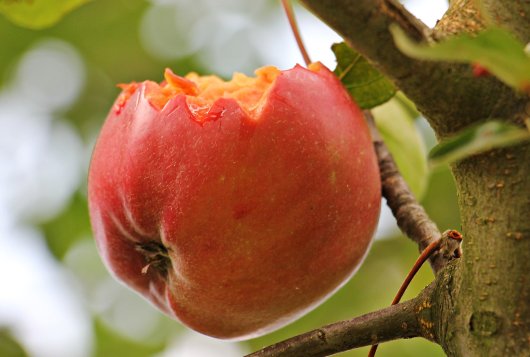Growing apples and pears organically under hail nets, what are the ins and outs?

Back in 2022, we wrote an article on the crop protection toolkit for fruit growing. The crop protection product toolbox is getting emptier and emptier. There are more and more stringent regulations on crop protection products. And then some apple and pear (hard fruit) growers are also switching from conventional to organic hard fruit production. What challenges are involved? And actually, most importantly, how do hail nets affect organic cultivation? What is already known about it? In this blog, we share all the practical information we have available!
From conventional to organic cultivation
The switch from conventional cultivation to organic cultivation is big. Fruit growers who have made the switch indicate that organic cultivation is still difficult. This is because the entire fruit farm has to be converted. Switching from conventional to organic takes 3 years for a fruit farm. Because of course, you don't get an official EU organic label overnight. Growing organically requires more knowledge and labour from the fruit grower. Organic apple and pear cultivation does not involve spraying (that is a FACT). In fact, there are aids you can use. There are biological pesticides against caterpillars, for example, and sulphur is used for scab control (fungal diseases). So there are natural organic pesticides that an organic fruit grower can use. Here you can find a table of which crop protection products you are allowed to use in organic apple and pear cultivation: https://www.iperen.com/fruitteelt/fruitgids-biologische-fruitteelt/. These agents are of natural origin and are often used when other (natural) control methods do not help. But in organic cultivation, you do face different or greater challenges than conventional cultivation. This is because your range of resources does tend to be more limited and some resources do not prove to be as effective or efficient. What are the challenges in organic cultivation and how do they relate to hail nets? Because anyone who already grows organically can agree that resources alone are not enough.
Did you know that Magic star is a suitable apple for organic cultivation? Magic star also thrives under hail nets!
Canopies with hail netting and organic cultivation
We would like to discuss the challenges below in relation to hail nets:
- Scab, mildew and storage rot (fungal diseases);
- Fruit tree cancer;
- Insects including the: Apple blossom beetle and pear bud beetle.
- Holding back plant protection products from neighbouring plots?
Canopies with hail nets naturally have the great advantage of protecting against increasingly extreme weather conditions. Don't want apple sauce or pear jam? Then hail nets are a right investment to protect your hard fruit. Only besides the benefits that hail nets protect against hail, hail nets can also protect against fungal diseases, fruit tree canker and insects (such as the apple blossom beetle and the pear bud beetle).
Trials of canopies over organic hard fruit crops have already been conducted since 2019. Trials are being conducted with rain shelters and hail nets to see what advantages and disadvantages they bring to organic cultivation.

Fungal diseases
Hail nets have so far achieved good results for scab control in apple cultivation. Indeed, it appears that covered cultivation can greatly reduce scab infestation. Those studies also show that rain covers, such as the PowerFlex Foil System, give even better results than hail nets for controlling fungal diseases, such as scab and storage rot.
On the other hand, rain shelters (permanent shelters) give greater challenges in the form of mildew and blood lice, but that also varies from year to year! Hail netting is also permanent, but it does give the orchard more "air" because it is not completely closed like the rain film in rain shelters.
Fruit tree cancer
Fruit tree cancer is actually a problem at all sites where apples and pears are grown. It also turns out that covered cultivation can greatly reduce fruit tree cancer infestation.
As Proeftuin Randwijk describes in one of its studies:
"Given the positive effects of canopy on preventing fruit tree canker and given that over the years an observed that picking wounds are the most susceptible to fruit tree cancer, a new trial has been set up this year in collaboration with EFC, where the trees are canopied with a Fruitsecurity Powerflex system from shortly before to a few weeks after harvest. Here, the trees are normally just under a hail net and shortly before picking, the rain canopy is closed. This is similar to the system used in cherries."
Bonus: Did you know that US research has shown that plastic (plastic) wires cause 50% to 75% fewer fruit tree cancer infections than steel wires. It is therefore also definitely advisable not to use steel wires as support wires with apples and pears. Read all about plastic crop wires here: Bayco Wire.
Insects including the: apple blossom beetle and pear bud beetle
The apple blossom beetle and pear bud weevil are becoming an increasing problem in hard fruit growing. The beetles enter your orchard and eat everything. The beetles actually have no natural enemies and even in conventional cultivation, a well-known pesticide may no longer be used to control the beetles. However, the apple blossom beetle and pear bud weevil can be controlled with a biological agent Raptol. Only for hard fruit growers is this no longer allowed (2023). So what can you do to control apple blossom beetle and pear bud weevil?
Rien van der Maas of Wageningen Plant Research explains:
"We hypothesise that by applying covered apple cultivation, it will be possible to reduce the use of plant protection products by 70% to 90%. In this way, we will contribute to a switch to physical and biological ways of controlling pests and fungi."
Physical and biological ways to control insect pests? With a canopy with hail nets, you can close the sides of the system to keep beetles out of your orchard. Closed sides to hail nets and rain covers have also proven to stop the green apple bug. Growers then do not need to use plant protection products to protect their apple or pear crops from these pests!

Bird damage
In addition, fruit crops are also facing increasing damage from birds. According to the NFO, birds are ahead of the problem. Among pear growers, 2.23 million in tit damage was reported last year (2022), according to the NFO! Damage also increased in apple cultivation, and damage by other bird species is also increasing. The advantage of roofed cultivation, such as canopies with hail nets, is that you can close the sides of the system and the top is closed. That way, maggot damage and damage by other bird species can be easily prevented.
Bonus tip: Did you know that hail nets also prevent sunburn on apples and pears as an added benefit? Watch the video here:
Holding back plant protection products from neighbouring plots?
In the studies on organic cultivation in hard fruit, another pressing question is how to stop drift of crop protection products from neighbouring plots. Suppose your neighbours are not organic growers or do not want to become so for the time being, you have to take into account the drift of crop protection products from them. There are studies on whether a hedge or a screen is enough to protect organic fruit from these unwanted residues.
Shade nets or windbreak netting not only can protect against unwanted residues, but also have the added benefit of protecting your crops from strong winds and bright sunlight. Leaf burn, fruit burn, sunburn all become a thing of the past!
However, other research has shown that hedges with certain, varied trees can again serve as host plants for natural enemies. This is of course very nice in organic cultivation.

To conclude:
Hail nets give many advantages to conventional, but therefore also organic cultivation. Several studies are still ongoing, but the first results are promising for the organic fruit grower! Covered cultivation reduces scab and storage rot, mildew and blood lice still remain challenges. Overcropping also gives very good results against fruit tree canker. In addition, insects including the apple blossom beetle and the pear bud weevil can be stopped with hail nets. You then do not need to use plant protection products to protect your apple or pear crop from these pests. Birds then naturally stay out of the orchard too! So harvest security offers better selling price, higher value and future-proofing to your (organic) fruit growing business.
Just a word to consumers and supermarkets:
Fruit is divided into different classes, class 1,2 and 3. Class 3 is only for industry and class 1 is mainly supermarket fruit. Class 1 is mainly about the looks of the fruit. So shape, colour, amount of blush, etc. etc. As an example:
Pears (Conference) naturally have a bronze colour and are a bit rougher. Only with conventional cultivation do you have a lot of pesticides to make it smoother. Natural biocides cannot do that as much and therefore the Conference pear becomes somewhat bronze and rougher.
When supermarket chains and consumers just allow the "mavericks" on the shelves (consumers often don't even see the difference), it also becomes easier for fruit growers to use less or no pesticides. Nature does not let itself be pigeonholed!
Source list
Reformatorisch Dagblad, 05-07-2023, 53E JAARGANG NR.79, Fruittelersclub slaat alarm over schade door appelbloesemkever.
De Fruitteeltkrant NR. 1/2019 april.
Nieuwsbrief Proeftuin Randwijk 2022-09
Corline van Egeraat, GroentenNieuws.nl, Kap voor appelteelt: minder nattigheid, minder plagen.
Jans Knoops, www.npv-pomospost.nl.
Peter Urbanus, Nieuwe Oogst, Fruitteler Wisse: “Het is met de kwaliteit alles of niks”.
Proeftuin Randwijk: Appelbloesemkever proef 2022: bestrijding na de bloei.
Joost van Winsen, Nieuwe Oogst, Fruitmasters test biologische teelt conceptrassen.
Michel de Vries, RTL-nieuws, Kever vreet appelbomen kaal – en daar is niets tegen te doen: “Desastreus voor oogst”.
Beren Jan van Westreenen, Fruitpact, Telen met een knipoog naar duurzaamheid
Peter Durlet, Depa-Fruit, Bio Journaal, “Niet overkapte kersenteelt is voor 100% naar de vaantjes.”
Jeroen Verheul, Groenten & Fruit, Schurftmiddel voor bioteelt, overkapte teelt hoopvol.
Vilt.be, Jef Vercammen, Overkappen hoort bij professionaliseren kersenteelt.
|
Rick Mudde Product specialist fruit canopies My mission is to help as many fruit growers as possible get a good harvest. So that fruit damage can be prevented, no delivery problems occur, and fruit growers can harvest successfully! |





.JPG)
